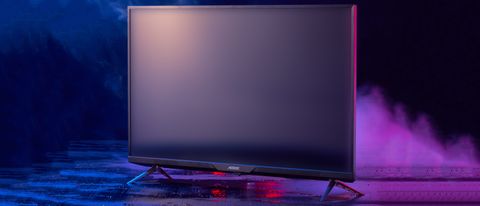TechRadar Verdict
An ungodly sized missing link between gaming monitors and TVs. But it’s not a great TV replacement.
Pros
- +
Fabulous gaming display
- +
Proper HDR
- +
Excellent LED backlighting
- +
Great speakers
Cons
- -
Too big for regular office work
- -
Not cheap
- -
Strange port placement
Why you can trust TechRadar
Two-minute review
When a gaming monitor hits 43-inches, you might simply wonder why you wouldn’t buy TV instead – larger models are much cheaper than this after all. It’s a question that took a while for us to answer, but the Gigabyte Aorus FV43U certainly offers things that most monitors cannot, and which standard TVs struggle with.
Sitting up close to this monster initially feels like you’re a naughty two-year-old staring at the TV from way-too-close. For office applications, especially, you’ll need to be turning your head side to side and up and down to see from one end to the other. The 3,840 x 2,160 resolution is just sharp enough for regular office work, but only just.
The lower-than-normal pixel density means you can see pixilation in lettering where you shouldn’t if you don’t get your Windows scaling settings right. To be frank, this wasn’t ideal for extended working, as the regular head movement gets wearying on your neck, shoulders and eyes. Nonetheless, there were times where spreading several, fully-open documents across a screen at once became a productivity boost.
That aside, this being a gaming monitor means it lives and dies by its gaming performance. Quantum Dot-generated colors are bright and vibrant. A 144Hz refresh rate (with 1ms MPRT) keeps motion smooth in fast-and-frantic shooters and this is enhanced by VRR (Variable Refresh Rate) to stop graphical tearing. There’s also ALLM (Auto Low Latency Mode) which tells the screen that a console is connected and requires a low-latency connection.
Meanwhile banks of rear-lit LEDs can generate 1,000 nits of brightness (and subsequent heat!) which makes HDR-enabled games look phenomenal – perhaps a even a bit too intense if you’re sitting too close when everything fully lights up. 10-bit color helps ensure that color gradients are smooth, although we did notice some banding appear in monochrome gradients.
It’s a decent technical performer too: covering 97% of the DCI-P3 color gamut, and each unit is factory-calibrated. Ultimately, gaming and multimedia content looks stunning… so long as you sit back from the screen.
The built-in speakers are very impressive: they get very loud and provide good, all-round fidelity with punchy bass. Gaming features include a black equalizer to reveal enemies hiding in shadows; on-screen crosshairs; Picture-in-Picture and intricate color controls. There’s even a KVM function that lets you connect a single keyboard and mouse to the monitor and have it act as an input hub for other devices (via USB-C).
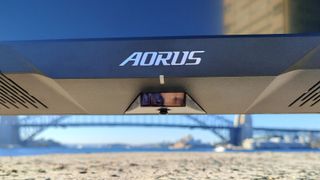
Price and release date
Gigabyte announced the Aorus FV43U gaming monitor in April 2021, and it's available now in most markets for $1,100 / £1,000 / AU$1,699.
Design
In terms of looks, the Aorus FV43U looks more like a TV – and quite a frumpy one at that. The thick, black plastic bezel might have some subtle brushed designed elements, but if you’re expecting the flashing lights and design flourishes seen on many, top-end gaming monitors, you’re out of luck.
Conversely, it seems the rear there is where the designers’ attention has been focused, although few people are likely to see those. The two double-pronged feet don’t allow for any adjustment but, to be fair, you’re not going to be tilting multiple monitors or swivelling, pivoting and rotating a monitor this big lest you might injure someone.
Unlike so many modern TVs, it’s also quite thick. However, this is to house the banks of mini-LED arrays which allow for precise backlighting in the form of very high contrast and proper High Dynamic Range imagery. Just note that when they’re all firing, the screen gets hot (mainly at the top), which is a common issue with this technology.
A bolted-on IR receiver at the base of the screen enables the included IR remote to function. There's also a nub-like joystick button which will enable OSD navigation when you’ve lost the small black remote.
While the OSD that’s controlled by these inputs is very-well featured, it’s not the most intuitive to use, nor does it offer the most refined-looking graphics and labels with everything looking heavily pixelated and raw. It leaves you with a feeling of it being half-baked rather than being an interpretation of an 80’s graphical throwback. However, we can’t fault the accuracy of the functions when enabled.
A major gripe is port placement. The power lead plugs into the left of the screen, while the computer cables plug into the right. If you’re using all the cables at once they don’t look very neat unless you find a way to tie them together behind the screen – there’s no cable tidy system like you’d find on any decent TV or monitor.
Furthermore, unless you have long, high-quality computer cables that stretch all the way to the right-hand side of the screen, you probably won’t be able to have your computer (or console) positioned on the left, especially if your computer is on the floor and the monitor is on a desk.
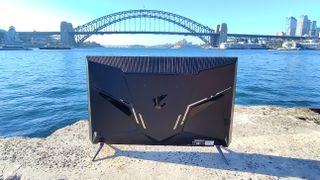
Features
There are a bunch of gaming features built in to the Aorus FV43U – many of which are only just starting to appear in high-end TVs. Black Equalizer is a feature that annihilates picture quality and contrast to help reveal enemies hiding in shadows.
Aim Stabilizer Sync is an interesting technology that, according to Gigabyte, “is able to conduct the motion blur reduction and V-Sync technology at the same time… greatly improving your FPS aim!” The word, “greatly” is a bit of a stretch there.
There is a variety of on-screen crosshairs to choose from, these are particularly useful in the likes of Call of Duty Hardcore Mode when you’ve only got an iron site available.
There’s Picture-in-Picture mode which is useful should you want to play a game while simultaneously following a walkthrough video. There are intricate (six-axis) color controls that let you adjust red, green, blue, cyan, magenta and yellow, plus numerous presets.
There’s even a useful KVM function that lets you connect a single keyboard and mouse to the monitor and have it act as an input hub for other devices using the USB-C port. Finally, there are many display options including, countdowns, timers, hardware information and technical display details.

Connectivity
All computer (and console) connectivity appears on the right-hand side of the screen. There’s a DisplayPort 1.4 socket, two HDMI 2.1 ports, two USB-A 3.0 ports, USB-B, USC-C, two 3.5mm audio jacks and an IR Remote. HDMI, DisplayPort and USB-B cables are included.
Performance
The Aorus FV43U’s screen is technically matte, so it’s nowhere near as glossy as a regular TV, but it’s not quite as good at reflecting glare and eliminating reflections as some monitors. Still, this is only really an issue when a screen goes very dark and you end up looking at yourself.
In this regard alone it will attract some buyers – large-screen displays without the gloss are hard to come by and this can be a key reason for choosing a large gaming monitor over a TV.
We found that office work was best if we picked a quadrant and stuck with it. With the correct magnification, text and spreadsheets were perfectly usable and it was good to be able to have secondary applications just a glance away on another part of the screen. Looking around regularly fatigued our neck and strained our eyes a bit too much, however.
But, once we got into the swing of things it was fine. We also found that working with the low-powered “Green” pre-set image setting was best for work as everything else got very bright very quickly.
Having a VA panel with Quantum Dot technology suggests that colors will be vibrant and viewing angles better-than-average and we can’t disagree. While color inversion manifests when looking in from the sides (more than decent TVs), this isn’t the size of screen that many people are likely to bunch around.
The 144Hz refresh rate keeps motion buttery smooth for fast-and-frantic gaming while ghosting and motion blur are kept at bay thanks to a 1ms MPRT (Motion Picture Response Time) rating.
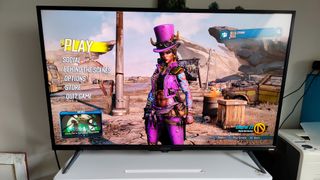
While TVs are continually getting better at catering for gamers, they generally don’t get past 120Hz, and the ones that do cost a fortune. This is another reason for choosing a gaming monitor over a TV – especially for PC users.
Other console-friendly performance enhancements come in the form of ALLM (Auto Low Latency Mode) which tells the screen that a console is connected and requires a low-latency connection, plus VRR (Variable Refresh Rate) to stop graphical tearing. These tend to be TV-oriented features for consoles and not always found in gaming monitors. It’s worth noting that neither FreeSync nor G-Sync are supported by the Aorus FV43U which is a little odd for a gaming monitor.
We’ve been disappointed with the watered-down versions of HDR that manufacturers are saying their products support in recent times. However, the (unspecified number of) banks of rear-lit LEDs can generate peak 1,000 nit brightness which leaves you (and your corneas) in no illusion that the HDR10 functionality of the Aorus FV43U is the real deal and that HDR-enabled games look phenomenal.
Far Cry 5 especially looked stunning when out for a walk in the woods or in a church illuminated by candlelight. However, when the drugged-up sister appeared and the screen flashed at maximum brightness, it reminded us that sitting up close when gaming is not a good idea.
Elsewhere, 10-bit color helps ensure that color gradients are smooth although we did notice some banding appear in monochrome gradients. It’s a decent technical performer too: covering 97% of the DCI-P3 color gamut and each unit is factory-calibrated and comes with a printed-out report.

Contrast is also impressive with light bleeding ‘Halo effects’ surrounding bright objects on dark backgrounds kept to a minimum. However, when watching movies and TV the lack of image processing was noticeable – TVs will smooth-out colours and enhance object clarity with live processing at the expense of input lag.
Monitors will rigidly display what they’re told, as quickly as possible. It shows that if you expect to use this gaming monitor primarily for watching Netflix and the like, you may actually be disappointed.
Nonetheless, gaming and internet-oriented multimedia content looks stunning… so long as you sit back from the screen. Up close is like sitting in the front row at an IMAX: it sounds utterly-immersive on paper but in reality you’ll miss what’s happening in other parts of the screen and you’ll get a sore neck.
The built-in speakers are very impressive. Gigabyte tells us they deliver “Space Audio” with “Exclusive sound reinforcement techniques.” Whatever that means, the twin, 12-Watt speakers get very loud and provide good, all-round fidelity with punchy bass. Frankly, they’re the best monitor speakers we’ve ever heard and are better than many that you’ll find on non-premium TVs.
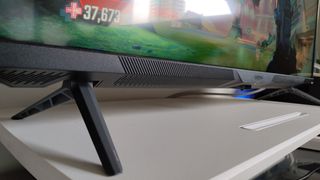
Should I buy the Aorus FV43U gaming monitor?
The Gigabyte Aorus FV43U gaming monitor reminds us that the key differences between it and a good TV are no TV tuner, no built-in operating system, no laggy input caused by image processing, a wider choice of inputs instead of additional brown-goods-friendly HDMI ports, a fast refresh rate and a matte screen. For many people the latter will be the key selling point over, say, a top OLED TV.
Its price will put many off but there’s no denying that this sits in a niche which many people will find attractive… particularly those whose primary use-case it to sit (well) back and use it for high-quality gaming and multimedia – with some office work in-between.
Buy it if...
You want a big screen for competitive gaming
Aorus FV43U offers better technical performance than a TV with a faster refresh rate, matte screen and multiple gaming-optimised image adjustments.
You need one, do-it-all screen for home
If you don’t have space for a monitor and a TV, this makes a great compromise.
You want great gaming HDR
If you don’t value your eyeballs, blast them with 1,000 nits of brightness.
Don't buy it if...
You want to use it as a TV
A television’s image processor is optimised for broadcast and streaming video and looks much the better for it. Netflix on a monitor can look raw and unrefined by comparison.
You want to use it for regular office work
While there are some benefits to having multiple windows open at once, regularly glancing up and down and side to side at them will hurt your neck and strain your eyes.
Your computer is on the floor to the left
The input ports are all on the right-hand side: you’ll struggle to reach them if your computer isn’t right next to the monitor.
- These are the best gaming monitors
